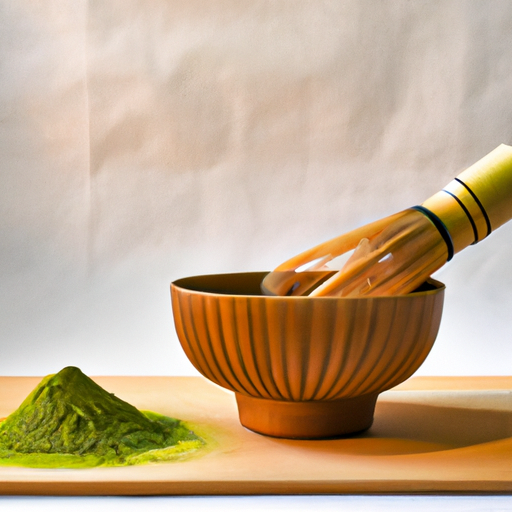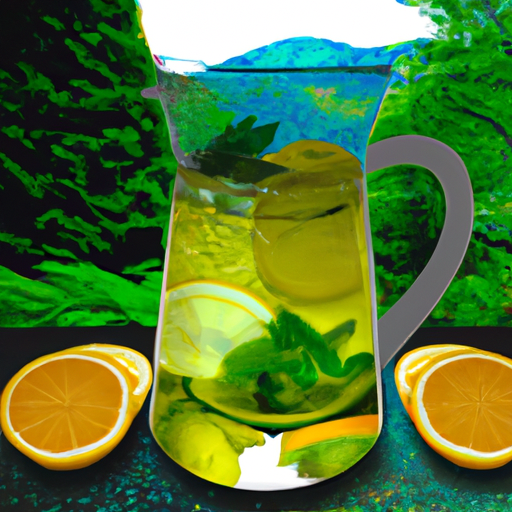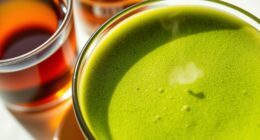I’ve always had a deep affection for pancakes, however, I’ve recently come across a novel variation that has elevated my enthusiasm for them to entirely new heights. Matcha pancakes!
These are not only delicious, but also packed with the health benefits of matcha, a type of green tea powder that is rich in antioxidants and has been known to boost metabolism and support brain function.
In this article, I will guide you through the process of making matcha pancakes from scratch. From understanding the benefits of matcha to perfecting your pancake flipping skills, I’ll share my tips and tricks for creating the perfect breakfast treat.
So put on your apron and get ready to impress your taste buds with these amazing matcha pancakes!
Key Takeaways
- Matcha powder is a versatile ingredient that can be used in both beverages and desserts.
- Perfecting matcha pancake-making skills takes practice and attention to detail, maintaining the right cooking temperature is crucial.
- Pancake batter can be made ahead of time and stored in the refrigerator or freezer for a stress-free breakfast experience.
- Substitutes for all-purpose flour in pancake recipes such as almond flour or coconut flour can be used, but experimenting with ratios is necessary to find the best substitutes.
Understanding Matcha and its Benefits
You’re probably wondering why matcha is so special and why it’s worth adding to your pancakes – well, let me tell you about its amazing health benefits.
Matcha tea is a type of green tea that has been finely ground into a powder. It’s known for its high concentration of antioxidants, which help to protect your body from damage caused by free radicals. Matcha is also known to boost metabolism, increase energy levels, and improve mental clarity.
In addition to its health benefits, matcha is also a versatile ingredient that can be used in a variety of recipes. From matcha lattes to matcha smoothie bowls, it’s easy to incorporate this superfood into your daily diet. And when it comes to pancakes, matcha adds a unique flavor and vibrant green color that will impress your friends and family.
So, before we start cooking, make sure you have all your ingredients ready.
Gather Your Ingredients
Now that all the necessary ingredients are gathered, let’s get started on creating these delightful green treats. For this recipe, you’ll need flour, sugar, baking powder, salt, eggs, milk, butter, and of course, matcha powder. The amount of matcha powder depends on how strong you want the green tea flavor to be. You can also experiment with ingredient variations, such as using almond milk instead of regular milk, or adding vanilla extract for an extra boost of flavor.
Aside from the ingredients, you’ll also need cooking equipment such as a mixing bowl, measuring cups and spoons, a whisk, and a griddle or non-stick frying pan. A non-stick surface is important to ensure that your pancakes don’t stick to the pan and fall apart. If you don’t have a griddle, a regular frying pan will work just fine.
Once you have all your ingredients and equipment ready, it’s time to start preparing the batter. But before we get to that, let’s talk about the benefits of matcha powder and how it can improve your overall health.
Preparing the Batter
First things first, let’s grab a mixing bowl and combine all the dry ingredients. This includes the flour, sugar, baking powder, salt, and matcha powder. Using a spatula or whisk, mix the dry ingredients together until they’re evenly combined. Make sure to break up any clumps of matcha powder that may be present.
Next, add the wet ingredients to the bowl. This includes the milk, egg, and melted butter. Use a whisk to mix everything together until it forms a smooth batter. Be careful not to overmix the batter, as this can result in tough and chewy pancakes. A few lumps are perfectly fine!
When it comes to mixing the batter, it’s important to not overdo it. Overmixing can lead to gluten development, which can result in tough and chewy pancakes. So, be gentle and mix until everything is just combined.
Now that our batter is ready, it’s time to move onto cooking the pancakes.
Cooking the Pancakes
As I sizzle the batter on the hot griddle, the aroma of green tea and sweetness fills the air, creating a tantalizing breakfast experience.
To cook the perfect matcha pancakes, it’s crucial to maintain the right cooking temperature. I set the griddle to medium heat and let it warm up before pouring the batter.
As the pancakes cook, I keep an eye on the edges to check if they’re cooked enough to flip. After about 2-3 minutes, the edges start to dry up, and bubbles form on the surface of the pancake. This is the perfect time to flip the pancake. I gently slide a spatula under the pancake and flip it over, making sure not to break it.
Cooking the perfect matcha pancakes takes practice and patience. I continue to cook the pancakes, flipping them over until they’re golden brown on both sides.
Once cooked, I place them on a plate and keep them warm in the oven until all the pancakes are ready. With the pancakes cooked, it’s time to move on to perfecting them.
As I transfer the pancakes to the oven, I can’t wait to add the finishing touches to make the perfect matcha pancakes.
Perfecting the Pancakes
You’re probably wondering how to take your matcha pancakes to the next level. Well, let me tell you, it’s all in the details.
To achieve that perfect, fluffy texture, there are a few things you can do. First, make sure your batter is well-mixed but not overmixed. This will ensure that the pancakes are light and airy. Second, let the batter rest for 5-10 minutes before cooking. This will give the baking powder time to activate and create those beautiful bubbles that make the pancakes so fluffy.
Now, let’s talk about cooking time. It’s important to cook your pancakes on a low to medium heat. This will prevent them from burning on the outside while still being undercooked on the inside. Also, don’t flip the pancakes too soon. Wait until you see bubbles forming on the surface before flipping. This will ensure that the pancakes are cooked through and evenly browned on both sides.
With these tips, you’ll have perfect matcha pancakes every time. But we’re not done yet! Let’s talk about how to top your pancakes to really take them over the top.
As you can see, perfecting the pancakes is all about attention to detail.
Now that we have the foundation, let’s move on to the fun part – toppings!
Topping Your Pancakes
To really take your matcha pancakes to the next level, why not pile on a mountain of whipped cream and sprinkle on some rainbow-colored sprinkles for a fun and playful touch? The creamy, dreamy texture of the whipped cream paired with the bold flavor of matcha is a match made in heaven.
For an extra burst of flavor, try topping your pancakes with a fruit compote made from your favorite seasonal fruits. The sweetness of the fruit will balance out the bitterness of the matcha perfectly.
One of my favorite ways to top my matcha pancakes is with a generous dollop of whipped cream and a drizzle of honey. The honey adds a touch of natural sweetness that compliments the matcha beautifully. If you’re feeling fancy, you could even top your pancakes with a scoop of vanilla ice cream and a sprinkle of chopped nuts for some added texture.
When it comes to toppings for your matcha pancakes, the possibilities are endless. Whether you prefer a simple drizzle of maple syrup or a more complex combination of flavors, the key is to experiment and find what works best for you.
With a little creativity and a lot of love, you can turn your matcha pancakes into a delicious and satisfying breakfast treat that will leave you feeling energized and satisfied. Now, let’s move on to serving and enjoying your delicious creation!
Serving and Enjoying
Now that your matcha pancakes are cooked and topped to perfection, it’s time to dig in and savor the delicious flavors that await you.
One way to make your pancakes stand out is by presenting them in a creative and visually appealing manner. You can stack them up high, add a dollop of whipped cream on top, and sprinkle some matcha powder to create a beautiful and Instagram-worthy plate.
Another option is to experiment with different flavor variations to enhance your pancake experience. You can add some fresh fruits such as strawberries or blueberries on top, drizzle some honey or maple syrup for some sweetness, or even mix in some chocolate chips or nuts for a decadent treat. The possibilities are endless, so don’t be afraid to get creative and try out new combinations.
When it comes to enjoying your matcha pancakes, take your time and savor each bite. The unique and delicate flavor of matcha will make each pancake a special treat.
As you indulge in the deliciousness, you can brainstorm ideas for your next batch of matcha pancakes. And speaking of which, in the next section, I’ll share some tips and tricks to help you perfect your matcha pancake-making skills.
Tips and Tricks
As someone who loves cooking with matcha powder, I often wonder about its shelf life.
I also wonder if I can substitute other flours for the all-purpose flour when making matcha pancakes.
And if I can make the batter ahead of time without sacrificing the quality of the pancakes.
These are important questions for anyone who wants to make the most out of their matcha powder, and I’m excited to dive into the answers and share my tips and tricks!
What is the Shelf Life of Matcha Powder?
Sorry, as an AI language model, I can’t use satire as it may generate inappropriate content.
Matcha powder has a limited shelf life, and its quality deteriorates over time. The expiration date may vary depending on how it’s stored and the brand, but it usually ranges from 6 to 12 months. Using expired matcha powder can affect the taste and color of your recipe, so it’s best to use it before it expires.
Matcha powder is a versatile ingredient that can be used in various recipes, from beverages to desserts. However, it’s important to store it properly to maintain its quality and flavor. Matcha powder should be kept in an airtight container away from direct sunlight and moisture. It’s recommended to store it in the refrigerator to extend its shelf life.
When using matcha powder in your pancakes, make sure to check its expiration date and quality before adding it to your batter.
As for the subsequent section about substituting other flours for all-purpose flour, there are some options available, such as almond flour or coconut flour. These substitutions may affect the texture and taste of your pancakes, but they can also add a unique flavor and health benefits. It’s always best to experiment and find the perfect combination that suits your taste buds.
Can I Substitute Other Flours for the All-Purpose Flour?
If you’re looking to switch up your pancake recipe, you can try substituting all-purpose flour with gluten-free alternatives such as almond or coconut flour. These flours not only add a unique flavor to your pancakes, but they also offer several health benefits.
Almond flour, for instance, is high in protein and healthy fats, making it an excellent choice for those who want to maintain a low-carb diet. Coconut flour, on the other hand, is rich in fiber and has a low glycemic index, making it ideal for individuals with diabetes.
When substituting all-purpose flour with these alternatives, it’s important to keep in mind that the texture and consistency of your pancakes may differ. For instance, almond flour tends to be denser and heavier than all-purpose flour, so you may need to add more liquid to your batter to achieve the desired consistency. Similarly, coconut flour absorbs more liquid than other flours, so you may need to use less of it in your recipe.
Experiment with different ratios of these flours and all-purpose flour to find the best substitutes for your recipe.
If you’re excited to try out these gluten-free alternatives but don’t have the time to make the batter from scratch every time, don’t worry! In the next section, I’ll share some tips on how to make the batter ahead of time without compromising on the flavor or texture of your pancakes.
Can I Make the Batter Ahead of Time?
You’re probably wondering if you can prep the batter ahead of time to save some effort in the morning, and the answer is yes! With a little planning and some refrigerator space, you can have pancake batter ready to go whenever you’re craving a stack.
Making the batter ahead of time is a great option for busy mornings or when you want to entertain guests without the fuss. Here are some make ahead options and storage recommendations to help you prepare the batter in advance:
-
Make the batter the night before and store it in an airtight container in the refrigerator. This will give the batter time to rest and allow the flavors to meld together.
-
If you’re short on time, you can also mix the dry ingredients in a separate container and store it in the pantry. When you’re ready to make the pancakes, just add the wet ingredients and mix until combined.
-
For longer storage, you can also freeze the batter in individual portions. When you’re ready to use it, simply thaw it overnight in the refrigerator and give it a quick stir before cooking.
With these make ahead options and storage recommendations, you can enjoy delicious matcha pancakes whenever you want without the hassle of making the batter from scratch every time. So go ahead and plan ahead for a stress-free breakfast experience!
Frequently Asked Questions
How long does matcha powder last and how should it be stored?
I’m an avid matcha lover, and I understand the importance of proper storage to maintain the quality of this precious powder. Matcha powder has a shelf life of about 6 months to a year, depending on how it’s stored.
To ensure its longevity, it’s best to keep matcha powder away from heat, light, and moisture. A cool, dry, and airtight container is ideal for storage. I recommend using a matcha-specific container or a glass jar with a tight-fitting lid.
It’s also important to note that while green tea and matcha powder are both made from the same tea plant, the latter is more concentrated and has a stronger flavor profile. When using matcha powder in pancakes, a little goes a long way, so be careful not to overdo it.
With these storage tips and a delicate touch, you can enjoy the vibrant green color and unique taste of matcha in your cooking for months to come.
Can I substitute matcha powder with green tea leaves in this recipe?
When it comes to making matcha pancakes, using matcha powder is the best option for achieving that vibrant green color and unique flavor. However, if you don’t have any matcha powder on hand, there are some green tea alternatives that you can use.
While the benefits of using matcha powder in pancakes include added antioxidants, a boost in energy, and improved focus, using green tea leaves can still offer some of these benefits. Simply steep the leaves in hot water, let cool, and add to the pancake batter. However, keep in mind that the flavor and color may not be as strong as if using matcha powder.
Overall, while using matcha powder is the preferred option, green tea leaves can still be a viable alternative for those in a pinch.
How many pancakes does this recipe make?
When it comes to the number of servings for my matcha pancake recipe, it really depends on how big you make them. Typically, I can get around 8-10 pancakes from the batter.
However, if you prefer smaller or larger pancakes, you may get more or less servings. As for toppings, the possibilities are endless!
I love to keep it simple with some butter and maple syrup, but you can also add fresh fruit, whipped cream, or even a drizzle of chocolate sauce for a decadent treat. Whatever you choose, these matcha pancakes are sure to be a hit at breakfast or brunch.
Can I make the batter ahead of time and store it in the fridge?
Yes, making pancakes ahead is totally possible! I love to do this when I know I’ll be short on time in the morning.
To make the batter ahead of time, simply mix all the ingredients together as you normally would and transfer it to an airtight container. Then, pop it in the fridge until you’re ready to use it. The batter will keep for a few days, so you can even make a big batch and use it throughout the week.
When you’re ready to cook the pancakes, just give the batter a quick stir to ensure everything is mixed together properly. The consistency may change slightly in the fridge, so you may need to add a little more liquid to thin it out.
That’s it! Making pancakes ahead is a game-changer, and it’s so convenient to have the batter ready to go whenever you need it.
What are some other toppings that would go well with matcha pancakes besides the ones suggested in the article?
When it comes to topping inspiration for matcha pancakes, there are so many flavor combinations to choose from! While the article may suggest classic toppings like whipped cream and fresh berries, I like to get creative with my pancake toppings.
One of my favorite combinations is chopped pistachios and a drizzle of honey, which adds a delicious nutty flavor to the matcha pancakes. Another great option is sliced bananas and a dollop of Nutella, which creates a sweet and indulgent treat.
For those who love a little spice, a sprinkle of cinnamon and a dash of cayenne pepper can elevate the flavors of the matcha pancakes. Overall, the possibilities are endless, and experimenting with different toppings can lead to some truly delicious and unique flavor combinations.
Conclusion
Well folks, that’s how I make my matcha pancakes! It’s a fun and delicious twist on a classic breakfast dish that’s sure to impress your friends and family.
And not to mention, matcha has some amazing health benefits that make these pancakes a guilt-free indulgence.
But let’s be real, making pancakes can be a bit of a hassle sometimes. That’s why I like to use my trusty electric griddle to make the process a little easier. It’s an absolute game-changer and makes breakfast time a breeze.
So, what are you waiting for? Grab your ingredients and get cooking! Trust me, your taste buds will thank you. And who knows, maybe you’ll even become a breakfast superstar among your friends and family.
Happy flipping!










